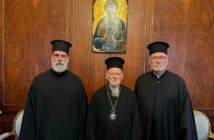Source: Public Orthodoxy
We Orthodox need to ask ourselves some hard questions about the episcopal ethos that has come down to us from Byzantium and was then magnified in the Russian tradition. This was an aspect of Orthodoxy that for his entire life troubled Fr. Sergius Bulgakov (1871-1944), one of the most prolific Orthodox thinkers of the 20th century. He came from a long line of priests in Russia but gave up on Christianity at age 14 because he despised the servility of the clerical world.
My revolt against my surroundings was morally right in so far as it was inspired by love of freedom and disgust at the servility which then reigned in the clerical world (and at that time it was the only world I knew). I did not want to be reconciled to it, indeed I could not be, and it would not have been right. I fled from it to save my spiritual integrity, and to this day I consider my flight justified.[1]
Bulgakov eventually returned to the Church and became a devoted priest, Professor of Dogmatics, and then Dean of St. Sergius Institute in Paris (we get a remarkable glimpse of his inner life in his Spiritual Diary, recently translated by Mark Roosien and Roberto J. De La Noval). He was devoted to the memory of Patriarch Tikhon (Bellavin, 1865-1925) who blessed him to be a priest, and he was grateful to Metropolitan Evlogii (Georgievskiy,1868-1946) for his active support in Paris, especially in times of theological controversy. And theologically he understood the bishop’s authority “as a mystical reality as evident as daylight.” But he remained deeply frustrated by his personal experience of episcopacy and believed that the Orthodox Church could do better.
Bulgakov saved his most trenchant essay on bishops for publication only after his death in 1944, hoping that he could then be completely honest. “The Episcopate” is a scathing attack on the shape that the institution of bishops had taken over the centuries. The post-Constantinian era abandoned the earliest model of sobornost (catholicity, conciliarity) that integrated bishops, clergy, and laity in an image of loving trinitarian communion, for an imperially-inspired system of episcopal control that became increasingly despotic. This only became more entrenched under the Turkocratia, as bishops inherited the trappings of the Byzantine emperors. Hence, the hierarchical liturgy as we know it today—its vestments, rites and accouterments—owes most to the rituals of the Byzantine imperial court.
I have to make this confession hoping that as a voice from the grave it will carry more weight and not be vitiated by any personal considerations. In my lifetime I endure the evil in silence, and my silence is partly due to lack of courage and partly the aversion I feel to the petty scandal to which such a protest of a little Russian Luther would inevitably give rise. As a matter of fact, it has nothing to do with Lutheranism or a desire to undermine the gracious power of the episcopacy, which is to me a mystical reality as evident as daylight. My “Lutheranism” is a struggle not against but for episcopacy, a striving to reclaim its true dignity, to free it from the contamination of despotism, based on a slavish psychology…
In the Russian Church one of the most important practical expressions of this tendency is the liturgical cult of episcopacy which imparts to divine worship the character of bishop-worship. The people love this ceremonial, they are brought up on it in the Church and, of course, are demoralized by this style of piety. The central nerve of prayerful life—the divine liturgy—is overshadowed by the pomp of the episcopal ritual, by the decorative and therefore religiously pernicious lengthening of the service. The real acting of it is only felt within the sanctuary, for the ikon-screen to some extent protects the congregation from the provoking spectacle; but it is difficult to think and speak calmly of this introduction of decorative show into the holy of holies under the pretext of piety.[2]
That was 1944, almost 80 years ago, but the situation remains largely unchanged throughout world Orthodoxy. One of Bulgakov’s most influential students, Fr. Alexander Schmemann (1921-1983), like Bulgakov, waited for the posthumous publication of his journals to express an equally honest critique. “I realize how spiritually tired I am of all this “Orthodoxism,” of all the fuss with Byzantium, Russia…and the more I think about the meaning of Christianity, the more it all seems alien to me. It literally obscures Christ, pushes him into the background.”[3]
About fifteen years ago I received an official letter instructing me about preparing for the approaching consecration of a new auxiliary bishop. It asked the deans across the diocese to prepare for the event by placing orders for the paraphernalia the new bishop would require. “In providing the necessary items, we help him to serve the Lord, and us also in a dignified and beautiful manner.” The list—with estimated prices—included the following:
1. White/Gold Bishop vestments
2. New cassock
3. New riassa
4. New klobuk
5. Mantia Dark Purple
5a. Mantia Black (Lenten)
6. Crosier [liturgical staff]7. Posokh [walking staff]8. Panagia set
9. Panagia
10. Cross for Mitre
11. Mitre White/Gold
12. Orlets Set [Eagle rugs]
13. Dikiri and Trikiri set [candle holders for blessing]
As a friend commented, this sounds like a bridal registry for bishops. I’m not quibbling about the need to purchase these items, or about their cost. As most clergy noticed, this was a very humble request for just the basic set at the lower end of the price range ($6650-$8700 at the time, and certainly much higher now). The way the system works, it’s hard to avoid any of this. The bishop-elect was a good man who deserved support as he embarked on his demanding new vocation. No monastic should be expected to have this cash on hand to outfit himself, and he needs to function in the Orthodox episcopal world as it is. But I do think we need to raise questions about this episcopal world of which these trappings are a symbol.
I know that there is a mystical interpretation of all this that sees the bishop as the sacramental embodiment of the true Emperor, Christ. I also know the argument that the church has matured, that it has remained the same at heart as what it was in the days following the first Pentecost, and that it only looks different now, in the same way that an adult is the same person they were as an infant. Still, for me, the whole contemporary hierarchical ethos requires too many mental gymnastics to believe that it represents a perfect continuity with the sobornost of the early church, and above all the teaching and simplicity of Jesus Christ “who emptied himself, taking the form of a servant” (Phil 2:7).
If I were to come up with a word for the characteristic Orthodox atmosphere surrounding bishops, it would be “episcopolatry.” I thought this was a made-up word, but to my surprise, it appears in the Oxford English Dictionary and is defined literally as “worship of bishops.” The OED also includes an example of its usage from an article in England’s Church Times from December 22, 1915, referring to those who in running away from Congregationalism and Presbyterianism go too far and “have cherished proclivities in the direction of Episcopolatry.”
Growing up in the “Metropolia” and Orthodox Church in America and experiencing this episcopal ethos over a period of more than forty years serving as a deacon and priest in Orthodox churches in various parts of the globe (Australia, the United States, Greece, England, and Canada), including a tenure as dean of a cathedral and as chancellor of the OCA, working closely with many bishops one-on-one and as a holy synod, traveling to various countries of the Orthodox world and being a regular participant in lavish hierarchical liturgical life, I’ve mused for some time about writing something on episcopolatry. My reaction has nothing to do with individual bishops, episcopal candidates, or entire synods. On the whole, they are prayerful and thoughtful, aware of the great responsibilities of their office and their own weaknesses. Many are good examples of hard work, humble service, and even a healthy sense of humor. My quarrel is not with them but with the ethos of the entire Orthodox world which has entrenched centuries-long “proclivities in the direction of Episcopolatry.”
Can’t we take a step back, look at what we do in this episcopal realm, and begin to question its value today? Can’t we commit ourselves to a leaner form of Orthodoxy that is simpler, less heavy and ossified, more sobornal, and more self-emptying?
[1] Sergius Bulgakov, “Autobiographical Notes,” in James Pain and Nicholas Zernov (eds.), A Bulgakov Anthology, London: SPCK, 1976, 3-4. Originally published posthumously in Autobiograficheskie Zametki, Paris: 1946.
[2] Sergius Bulgakov, “The Episcopate,” in Autobiographical Notes, in Sergius Bulgakov: A Bulgakov Anthology, edited by James Pain and Nicolas Zernov, London: SPCK, 1976, 15-21.
[3] Alexander Schmemann, The Journals of Alexander Schmemann, 1973-1983, translated and edited by Juliana Schmemann, Crestwood, NY: St Vladimir’s Seminary Press, 2000, 146). See John A. Jillions, “‘A Thicket of Idols’: Alexander Schmemann’s Critique of Orthodoxy,” The Wheel, 19 (Winter 2019), 20-28.
This is an abbreviated version of a paper given online at a conference of the St Philaret Institute (Moscow) on “The Sophiology and Ecclesiology of Fr Sergius Bulgakov and Fr Pavel Florensky,” 3-5 October 2022.
Fr John Jillions is former Chancellor of the Orthodox Church in America and a Visiting Professor of the Institute for Orthodox Christian Studies in Cambridge, England.





2 Comments
Father Jillion’s article on Episcopolatry is very timely given OCL’s persistent initiative for a united Orthodox Church in the U.S. The mandatory “veneration” of the hierarchy is the obstacle to an untethered Orthodox Church of America from foreign control and nationalist issues. Once these demigods are toppled from their imperial thrones maybe, we’ll see some progress toward a united church in the U.S.
Peter,
A united, autocephalous Orthodox Church in the United States is the only way to empower the bishops now assigned to serve the faithful in this land to become the Servant Leaders they are supposed to be.
As long as they are subject to the synods in the Old World that appoint and can depose them for any or no reason, the gilded robes, bejeweled crowns and miters are just costumes that disguise the fact that these emperors have no clothes.
Only when these bishops are part of a Synod that elects its own presiding head, leading an autocephalous local church, will they be free to grow the church rather than preside over its decline.
The inescapable reality is that the bishops who are members of the Assembly of Bishops of the United States are responsible for the continuing canonical disorder of the Church under their care. They cannot escape their responsibility by blaming the laity for its failure to rise up and demand that they do their jobs.
If the laity is largely uninformed about the canonical imperative of unity, who is to blame? Have the bishops preached and taught the laity that the current disunity makes a mockery of the canons and the prayers we pray at every Liturgy? Have the bishops empowered the clergy under their supervision to teach and preach on this issue?
Of course not!
Why not?
Are they afraid of being deposed, or transferred to a nominal see in Asia Minor if they dare to speak truth to power?
Rather than obsessing over the list of items they need to deck themselves out in imitation of byzantine imperial splendor, they should read the recently-published “Letter to the American Church” by Eric Metaxas, and his earlier biography of Dietrich Bonhoeffer to see what happens when church leaders fail to speak and to act. To quote from that book: “Not to speak is to speak.” “Not to act is to act.”